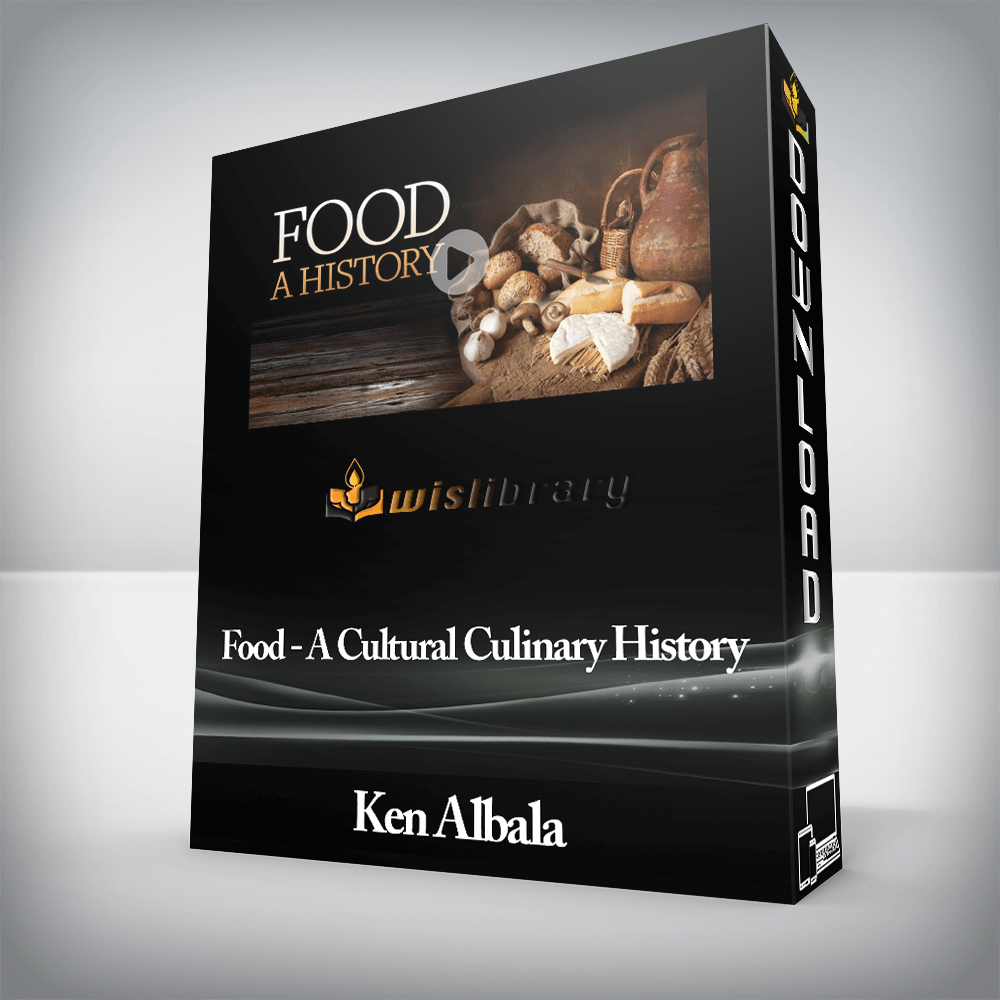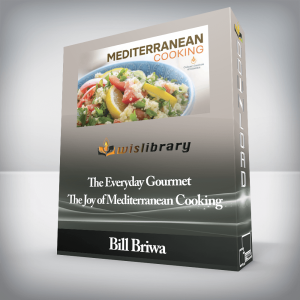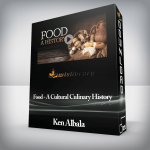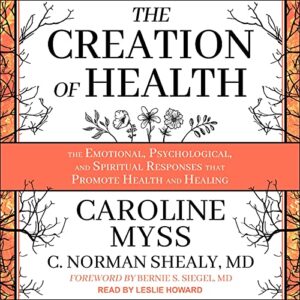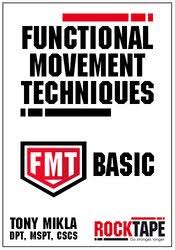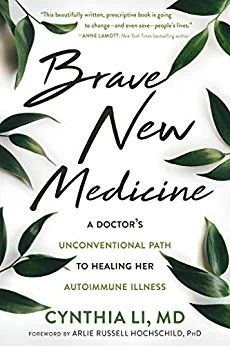Ken Albala – Food – A Cultural Culinary HistoryCourse OverviewEating is an indispensable human activity. As a result, whether we realize it or not, the drive to obtain food has been a major catalyst across all of history, from prehistoric times to the present. Epicure Jean-Anthelme Brillat-Savarin said it best: “Gastronomy governs the whole life of man.â€In fact, civilization itself began in the quest for food. Humanity’s transition to agriculture was not only the greatest social revolution in history, but it directly produced the structures and institutions we call “civilization.â€In every era, the unfolding of history has been intimately tied to the need for food, the production of food, and the culture of food. In all major religions, food choice has been an integral part of religious identity. The quest for spices and exotic foodstuffs led to the European discovery of the New World, as well as to the connecting of the entire globe through trade. In 1840s Ireland a single food—the potato—changed the course of history. Modern warfare, from Napoleon’s conquests to World War II, was made possible by advances in food technology.In our own times, more people worldwide now recognize the McDonald’s “golden arches†than the Christian cross. Beyond feeding our bodies, food choices and ideologies express social distinctions, as well as our values, concerns, and aspirations. For all of these reasons, food offers a deeply insightful lens on human history, shedding new light on the evolution of social and political systems, on cultural interactions, economic empires, human migrations, and more. Through food culture, we see how primary biological needs have shaped all human lives through the ages. The history of food is the history of human life at its most elemental, its most intimate, its most essential. It’s also a story of ingenuity, creativity, and remarkable human behavior to rival any other aspect of culture.In Food: A Cultural Culinary History, award-winning Professor Ken Albala of the University of the Pacific puts this extraordinary subject on the table, taking you on an enthralling journey into the human relationship to food. With this innovative course, you’ll travel the world discovering fascinating food lore and culture of all regions and eras—as an eye-opening lesson in history as well as a unique window on what we eat today.Incorporating extensive study of historical recipes, food preparation techniques from around the world, and activities you can try at home, these 36 colorful lectures take you through the entire spectrum of food history, from the cuisine of ancient Egypt to the great flowering of European cookery in the Middle Ages, and from the celebrity chefs of 18th-century France to our own Zagat- and Michelin-rated restaurant culture. Along the way, you learn in depth about food production and technology in each era; the social, economic, and political factors surrounding food culture; and thinking on diet and eating through the centuries. The result is a compelling inquiry that will change the way you look at both history and food itself.Food as a Driver of Human HistoryAs context for exploring humanity’s remarkable food cultures, you observe the integral role of food in the unfolding of civilization. From prehistory to our own era, your study includes these seminal subjects:The revolutions of agriculture: Learn how agriculture arose in the prehistoric world and how it spurred the development of urban organization, political systems, social classes, militaries, and trade.Food and faith: Grasp how food practices became core expressions of religious faith in Christianity, Judaism, and Islam, as well as in the Eastern traditions of Buddhism, Hinduism, and Taoism.1492 and food globalization: Track the great trading empires of the Venetians, Portuguese, and Spanish, and the “Columbian exchange,†where plants and animals from five continents were transplanted across the world.Coffee, tea, sugar, and slaves: Discover how the trade in a group of superfluous luxury items in the era of European colonialism altered the focus of the global economy.Eating in the Industrial Revolution: Learn how capital-intensive, mass food production in the Industrial Revolution forever changed human diet and nutrition.Big business and food imperialism: Observe the vast industrialization of food production in the late 19th and 20th centuries; its economic and human consequences; and the ideologies, movements, and practices that arose to oppose it.A Global Richness of Culinary CulturesAt the heart of the course, you delve deeply into classic food traditions around the world. Among civilizations of Europe, Asia, Africa, and the Americas, your inquiry highlights these traditions:Status and ritual in ancient Rome: Learn how Roman food reflected social rank, wealth, and sophistication, and investigate the dining habits of the upwardly mobile as well as the gastronomic eccentricities of the emperor Heliogabalus.The exquisite flavors of medieval Islamic cuisine: In a culture with no injunction against pleasure, learn how the medieval Muslims’ sensual dishes—richly spiced, colored, or perfumed—reflected visions of a paradise on earth.Aztec food culture: In this unique New World tradition, discover the Aztec way of life—the indigenous foodstuffs, eating rituals, and “signature†foods, from chilies to chocolate.Sumptuous dining in the Renaissance: Study the sophistication and complexity of Renaissance-era food culture in the writings of Platina, Ficino, and Messisbugo, and witness the extravagance of banquets at the court of Ferrara.The genesis of French haute cuisine: Grasp the aesthetics of French 17th-century cookery, based in refinement and pureness of flavors and study four Gallic cookbooks that revolutionized culinary history.“Scientific†cooking in the 21st century: In our own diverse era, encounter the phenomenon of “molecular gastronomyâ€â€”technology-enhanced food creations designed to titillate and amaze the palate.A Colorful and Diverse Learning ExperienceExpanding on the lectures and in-studio demonstrations of food preparation techniques, the course guidebook presents a series of 39 hands-on activities—where you can learn how to make everything from Egyptian beer to Elizabethan “Chickin Pyeâ€â€”that give you direct experience of how people cooked, ate, and thought about food in past eras. You also practice medieval eating rituals, track the rich evocation of food in art, and immerse yourself in the poetic ambiance of classic Japanese dining.Across the span of the centuries you sample important food writing from many cultures, from the world’s first surviving recipes written in cuneiform to the lavish dishes of Apicius of Rome, and from the classic medieval cookbooks of Taillevent and Chiquart to the 19th-century Guide Culinaire by Escoffier.And, throughout the series, the lectures pulsate with surprising and intriguing details of the human adventure with food:Dinner knives with rounded tips were developed to reduce the threat of violence at the table.The English word “dinner,†from the Latin disjejunare, literally means “break-fast.â€The banana, which we know as a single fruit, actually exists in hundreds of diverse varieties.The world’s first restaurant-based food culture was Edo-era Japan.The separation of sweet and savory flavors that we know today is relatively recent historically. Before the 16th century, meat and fish were often cooked with sugar, fruit, and syrups.The Middle Ages produced some of history’s most outlandish and theatrical presentations of food, such as gilded boars’ heads; “invented†creatures, mixing parts of different animals; and cooked peacocks spewing flames.Food: A Cultural Culinary History offers you an insightful and startlingly different view of our civilization that you won’t find anywhere else, revealing the development of societies and cultures through the single factor that has driven human life more than any other. In the process, you discover the stunning richness of world cultures as seen in their distinctive food traditions, and greatly broaden your own enjoyment of fine food.36 Lectures1Hunting, Gathering, and Stone Age Cooking2What Early Agriculturalists Ate3Egypt and the Gift of the Nile4Ancient Judea—From Eden to Kosher Laws5Classical Greece—Wine, Olive Oil, and Trade6The Alexandrian Exchange and the Four Humors7Ancient India—Sacred Cows and Ayurveda8Yin and Yang of Classical Chinese Cuisine9Dining in Republican and Imperial Rome10Early Christianity—Food Rituals and Asceticism11Europe’s Dark Ages and Charlemagne12Islam—A Thousand and One Nights of Cooking13Carnival in the High Middle Ages14International Gothic Cuisine15A Renaissance in the Kitchen16Aztecs and the Roots of Mexican Cooking171492—Globalization and Fusion Cuisines1816th-Century Manners and Reformation Diets19Papal Rome and the Spanish Golden Age20The Birth of French Haute Cuisine21Elizabethan England, Puritans, Country Food22Dutch Treat—Coffee, Tea, Sugar, Tobacco23African and Aboriginal Cuisines24Edo, Japan—Samurai Dining and Zen Aesthetics25Colonial Cookery in North America26Eating in the Early Industrial Revolution27Romantics, Vegetarians, Utopians28First Restaurants, Chefs, and Gastronomy29Big Business and the Homogenization of Food30Food Imperialism around the World31Immigrant Cuisines and Ethnic Restaurants32War, Nutritionism, and the Great Depression33World War II and the Advent of Fast Food34Counterculture—From Hippies to Foodies35Science of New Dishes and New Organisms36The Past as Prologue?There are no reviews yet.Add a Review Cancel replyYou must be logged in to post a review.
Ken Albala – Food – A Cultural Culinary History
₹4,814.00

